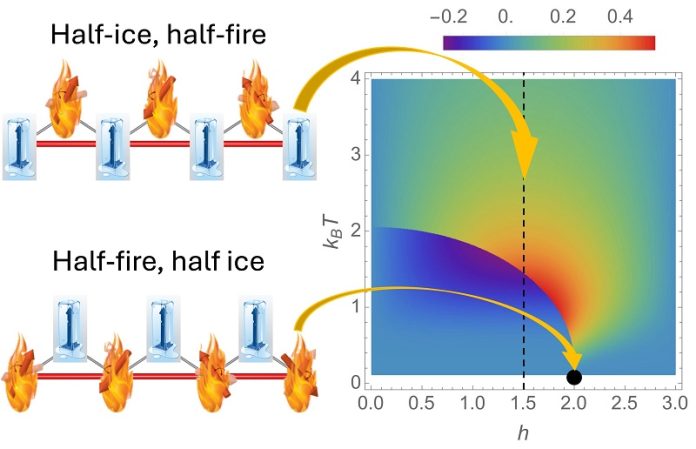
Physicists at the U.S. Department of Energy’s Brookhaven National Laboratory have discovered a brand-new phase of matter in a magnetic material.
This unusual state, which they call “half ice, half fire,” has never been seen before.
The name comes from what’s happening at the atomic level: in this new phase, some of the electron spins—tiny magnetic properties of electrons—are highly ordered and “cold,” while others are completely disordered and “hot.”
This strange mix makes it look like the material is both frozen and burning at the same time.
The discovery was made by researchers Weiguo Yin and Alexei Tsvelik, who were studying a one-dimensional model of a magnetic material known as a ferrimagnet.
Their results were published in Physical Review Letters on December 31, 2024.
What makes this phase exciting is that it can switch extremely sharply from one state to another at a specific temperature. That kind of fast switching is rare and could be useful for future technologies, such as energy-efficient cooling or advanced computer memory.
“Finding new states with unusual properties—and understanding how to control the switch between them—is a big deal in physics,” said Yin. “It could lead to breakthroughs in quantum computing and spintronics.”
This new phase is actually the mirror image of another strange state the team discovered earlier, called “half fire, half ice.”
That discovery happened in 2016 while the scientists were studying a magnetic compound made of strontium, copper, iridium, and oxygen (Sr₃CuIrO₆). In that earlier state, copper atoms had hot, disordered spins, while iridium atoms had cold, ordered spins.
But for years, the researchers didn’t fully understand how this state could be useful. It was thought that in one-dimensional systems like theirs, no phase transitions could happen at regular temperatures. Then recently, Yin showed that sharp crossovers between phases could occur over an incredibly narrow temperature range—something thought to be impossible before.
Now, in their latest study, the scientists found a hidden partner to their earlier phase: a reversed version where the hot and cold spins switch places. They named it “half ice, half fire.”
This switch between phases happens in an extremely small temperature window. That could make it useful for technologies like magnetic refrigeration or new types of data storage where each phase could represent a digital “bit.”
Yin says the team’s next step is to study how this fire-ice behavior works in systems with more complex features. “We’ve just opened the door to a lot of exciting possibilities,” he said.



